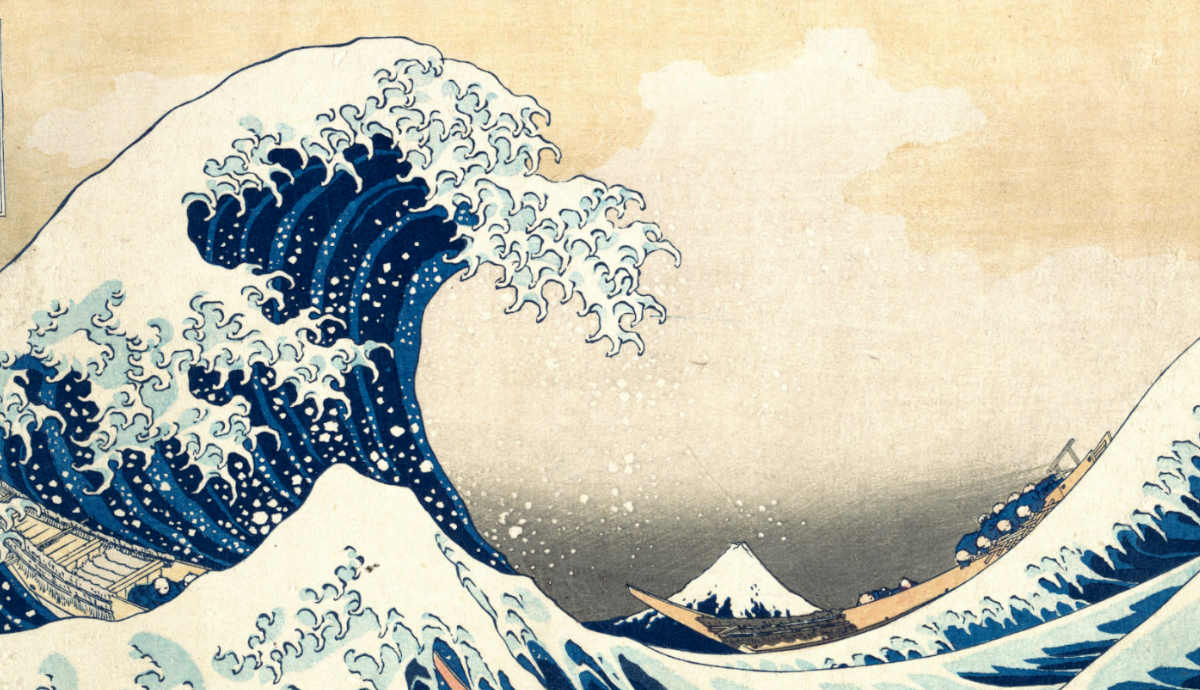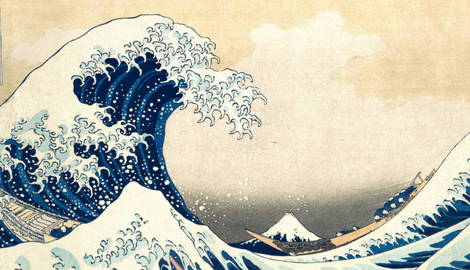-

The Great Wave, Katsushika Hokusai, ca. 1830–32, via Met Museum
Katsushika Hokusai (1760-1849) was a self-proclaimed “old man mad with painting” towards the end of his life. During his life time, he went by 30 different pseudonyms, moved 93 times, and created about 30,000 art works. Today, he’s remembered as one of the most important ukiyo-e artist in Japan, and the creator of the famous Great Wave off Kanagawa (c. 1829-1833).
Katsushika Hokusai: The Lifelong Eccentricity of a Tireless Artist

Hokusai was born in 1760 in Edo (present-day Tokyo), Japan, and his original name was Tokitarō. He began drawing when he was five years old, and worked as a clerk in a lending bookshop. When he was fifteen, he went into an apprenticeship to become a woodblock-engraver. Three years later, he studied under ukiyo-e master Katsukawa Shunshō.
Ukiyo-e was a Japanese art style that used woodblocks to print imagery and texts. It began in the early 17th century, when artists would use it to recreate designs on silk and paper. Soon, ukiyo-e became a very popular medium for mass production. It also became a symbol of wealth. People could buy prints depicting famous figures like actors, political leaders, or monuments of the natural world.
Hokusai followed this model’s footsteps. His first publications were prints of actors in kabuki theaters (where kabuki means a classical dance-drama performance). He continued to make art of actors, women, historical figures, and more into his 20s. It was around this time that he also married his first wife, who would pass away later around the time that he would adopt the name Hokusai.

Hokusai kept honing in on his skills, and began reaching higher success when he entered the surimono genre of art. This style was defined by print making for special occasions like New Years. It was aimed at those who wanted to make personal, unique invitations with high quality.
His golden age truly began after this phase. In 1793, his master Shunshō died and his wife passed away soon after. Hokusai was left with a son, and two daughters. Four years later, he married his second wife, and adopted the name we know him by today.
Hokusai became well known for making wild displays of art in public. He made paintings that were 2,000 sq. ft large in festivals. A hard worker, he would wake up very early, and keep working into the late night.

In 1828, Hokusai’s second wife died. This time, he had his favorite daughter, Oī, who lived with him and worked beside him for years. Hokusai was 68 years old, partially paralyzed, and angry at the fact that his son was a delinquent. Therefore, he dedicated time to teaching Oī art. Although her talents were not as recognized as her father’s, the anime film Miss Hokusai (2015) pays homage to her and her father’s story.
Ever-changing, Hokusai continued to move every time his studio got too dirty. He also frequently changed his artist name. Although this was common for Japanese artists in his era, they often reached 30 changes. Some of Hokusai’s professional names include Shunrō, Sōri, Kakō, and Taito.
By the end of his life, the pseudonym to grace his tombstone was Gakyo Rojin Manji. This phrase means “old man mad about painting” which is just part of what he is lovingly remembered for today.
Hokusai’s Impact: The Great Wave off the West

The mad man made his most famous work when he was into his 70s. The Great Wave of Kanagawa is a wood block print depicting Mount Fuji, the popular symbol of Japan’s soul, in the cusp of a giant wave. The print was part of a series called 36 views of Mount Fuji. The collection was expanded to 46 prints because it reached acclaimed success. Although the original woodblock has been worn out, its medium means that there are several prints of it across major museums. According to the British Museum, there are still hundreds of original impressions in existence.
Although originally popular in japan, The Great Wave is credited for inspiring the Impressionist movement in Paris. In fact, some say that the movement would have never happened if Hokusai’s influence didn’t go abroad.
Japan had isolationist policies until the 1850s, which was just around the time Hokusai died. During his lifetime, the nation’s contact with foreigners was wildly limited. Yet, the saturated blue of The Great Wave was actually made of Prussian blue pigment. Since he made it in 1830, this leaves a curious story of how he obtained the foreign hue.

Some people believe that the European pigment gives a new meaning to the art. As Mt. Fuji represents the soul of Japan, some view the work as a symbol of Japan standing firm in the wave of foreign changes and influences to come.
When Hokusai died, and Japan opened its borders, The Great Wave was one of the first Japanese pieces to go to Europe. There, it inspired Vincent van Gogh, Claude Monet, Degas, Henri de Toulouse-Lautrec, and more.
Degas took inspiration from the way Hokusai drew the human form, and Toulouse-Lautrec mirrored his depictions of ordinary life. It’s possible that Claude Monet was inspired by Hokusai’s floral artwork to create his water lilies. As Japan adopted trends from the West in an effort to modernize, France also adopted inspiration from Japanese masters.
Contemporary Effect: Worldwide Fame

Today, Hokusai’s work continues to reach people in every continent. Even those who aren’t interested in art can often recognize the pieces. While The Great Wave was originally printed on items like silk or paper, now it can be seen on a variety of different mediums like socks, phone cases, books, and other pop culture media.
What’s less known is the initial impact and interesting life of the mad man himself. Together, they’re more than enough reason to see why Hokusai was such a memorable character.







